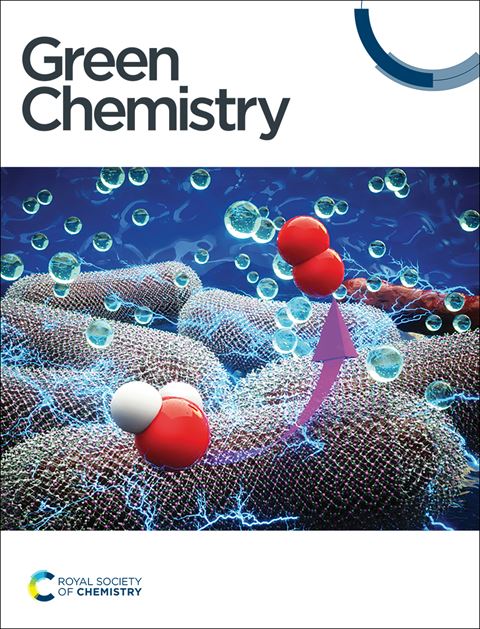Influence of functional additives, fillers, and pigments on thermal and catalytic pyrolysis of polyethylene for waste plastic upcycling†
IF 9.3
1区 化学
Q1 CHEMISTRY, MULTIDISCIPLINARY
引用次数: 0
Abstract
Pyrolysis offers a relatively green and economical method to convert waste plastics into valuable chemicals and fuels without the need for harmful solvents, toxic chemicals, or costly high-pressure reactors. Despite its popularity among chemical upcycling technologies, industrial adoption suffers from feedstock heterogeneity, low-quality products, and catalyst deactivation. Most plastics in our daily lives are formulated with functional additives, fillers, and colorants. These additives remaining in end-of-life waste streams increase feedstock heterogeneity, creating a challenging issue in recycling plastics. Still, the potential impacts of additives on the chemical upcycling of plastics have been poorly understood. In this study, polyethylene compounded with a range of widely used additives (antioxidants, stabilizers, pigments, fillers, slip agents, and flame retardants) was subjected to both thermal pyrolysis and catalytic pyrolysis in different catalyst-to-feedstock contact modes. It showed that many inorganic additives, such as talc, kaolin, CaCO3, TiO2, carbon black, and zinc stearate, facilitated polymer decomposition during pyrolysis, increasing light hydrocarbons while also promoting aromatic and carbon residue formation. Conversely, antioxidants and stabilizers inhibited depolymerization, favoring heavier hydrocarbons. During catalytic pyrolysis with HZSM-5 zeolite, additives strongly enhanced aromatic and catalytic coke formation, especially when there was direct contact between plastics and catalysts. Although certain additives seem beneficial in the short term by promoting polymer cracking and improving the selectivity of aromatics, the transport of the additives and their degradation products and increased carbon coking can contaminate products, deactivate or modify catalysts, and foul reactors. These findings address a critical knowledge gap in effectively converting waste plastics via a greener route.
功能助剂、填料和颜料对废塑料升级回收中聚乙烯热裂解和催化热解的影响
热解提供了一种相对绿色和经济的方法,可以将废塑料转化为有价值的化学品和燃料,而不需要有害溶剂、有毒化学品或昂贵的高压反应器。尽管它在化学升级回收技术中很受欢迎,但工业应用受到原料异质性、低质量产品和催化剂失活的影响。我们日常生活中的大多数塑料都含有功能性添加剂、填料和着色剂。这些残留在报废废物流中的添加剂增加了原料的不均匀性,在塑料回收中产生了一个具有挑战性的问题。尽管如此,添加剂对塑料化学升级回收的潜在影响还知之甚少。在本研究中,聚乙烯与一系列广泛使用的添加剂(抗氧化剂、稳定剂、颜料、填料、滑脱剂和阻燃剂)复合,在不同的催化剂-原料接触模式下进行热热解和催化热解。结果表明,滑石、高岭土、CaCO3、TiO2、炭黑、硬脂酸锌等无机添加剂在热解过程中促进了聚合物的分解,增加了轻烃,同时促进了芳香烃和碳渣的形成。相反,抗氧化剂和稳定剂抑制解聚,有利于较重的碳氢化合物。在HZSM-5沸石催化热解过程中,添加剂对芳香烃和催化焦的形成有较强的促进作用,特别是当塑料与催化剂直接接触时。虽然某些添加剂通过促进聚合物裂解和提高芳烃的选择性在短期内似乎是有益的,但添加剂及其降解产物的运输和增加的碳焦化会污染产物,使催化剂失活或改性,并污染反应器。这些发现解决了通过更环保的途径有效转化废塑料的关键知识差距。
本文章由计算机程序翻译,如有差异,请以英文原文为准。
求助全文
约1分钟内获得全文
求助全文
来源期刊

Green Chemistry
化学-化学综合
CiteScore
16.10
自引率
7.10%
发文量
677
审稿时长
1.4 months
期刊介绍:
Green Chemistry is a journal that provides a unique forum for the publication of innovative research on the development of alternative green and sustainable technologies. The scope of Green Chemistry is based on the definition proposed by Anastas and Warner (Green Chemistry: Theory and Practice, P T Anastas and J C Warner, Oxford University Press, Oxford, 1998), which defines green chemistry as the utilisation of a set of principles that reduces or eliminates the use or generation of hazardous substances in the design, manufacture and application of chemical products. Green Chemistry aims to reduce the environmental impact of the chemical enterprise by developing a technology base that is inherently non-toxic to living things and the environment. The journal welcomes submissions on all aspects of research relating to this endeavor and publishes original and significant cutting-edge research that is likely to be of wide general appeal. For a work to be published, it must present a significant advance in green chemistry, including a comparison with existing methods and a demonstration of advantages over those methods.
 求助内容:
求助内容: 应助结果提醒方式:
应助结果提醒方式:


